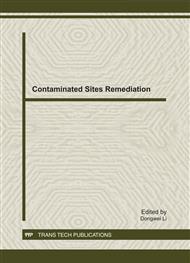p.32
p.39
p.45
p.51
p.56
p.63
p.68
p.76
p.83
Detoxification of Chromium-Containing Slag by Chromium-Resistant Bacteria
Abstract:
Chromium-containing slag is one of the most hazardous solid waste because of the high content of dissolvable Cr (VI). Bacterial strains which can remove Cr (VI) efficiently were isolated from chromium-containing slag. The effect of processing parameters, such as quantity of chromium-containing slag, initial pH, temperature and agitation speed on the detoxification of chromium-containing slag were detected in the experiment. The results shows that the detoxification effect is reduced along with the quantity of chromium-containing slag is increased, and the optimized parameters for removing Cr (VI) from chromium-containing slag using the mixed strains are as follows: temperature = 30°C, pH = 7.0, agitation speed = 150 rpm. The detoxification experiments of the mixed strains indicated that the detoxification of chromium-containing slag is related to the growth law of the microorganisms, and the removal of Cr (VI) occurred primarily in the first 24h which is the exponential growth period of the mixed strains. At the same time, the bacterial strains can efficiently accelerate Cr (VI) leaching rate and remove it.
Info:
Periodical:
Pages:
56-62
Citation:
Online since:
December 2011
Authors:
Price:
Сopyright:
© 2012 Trans Tech Publications Ltd. All Rights Reserved
Share:
Citation:


